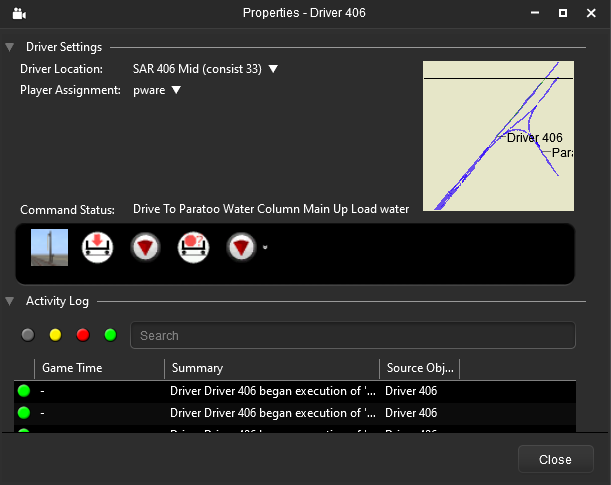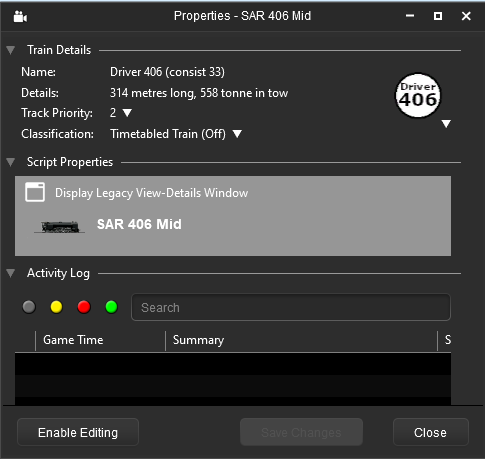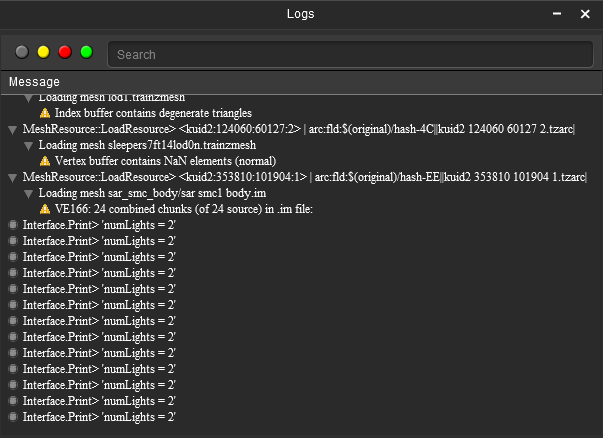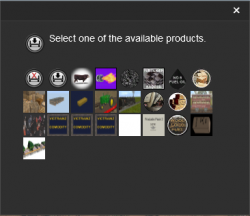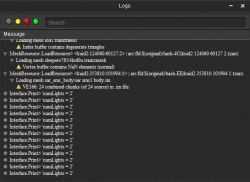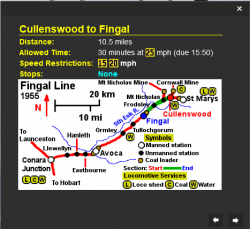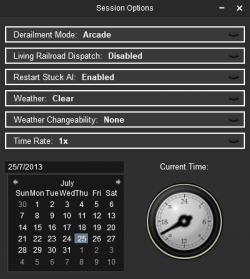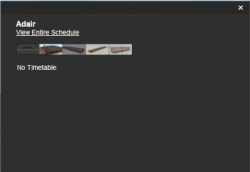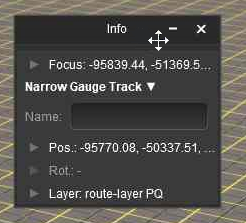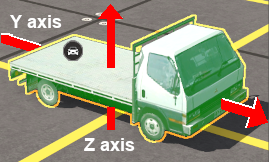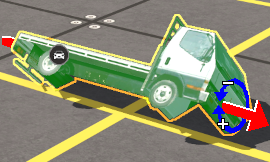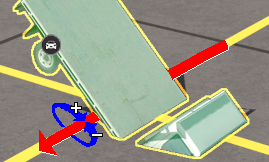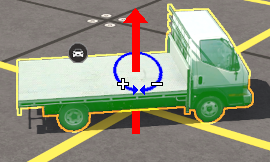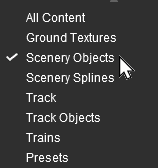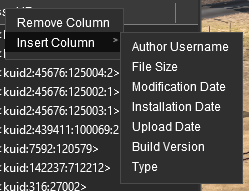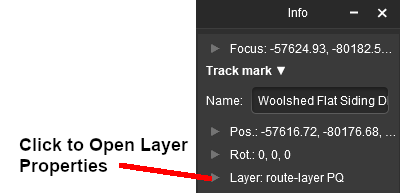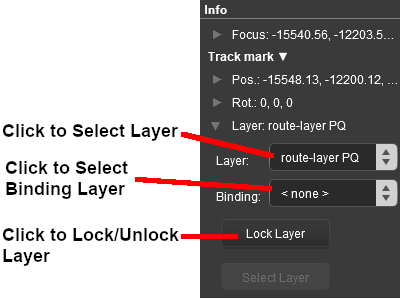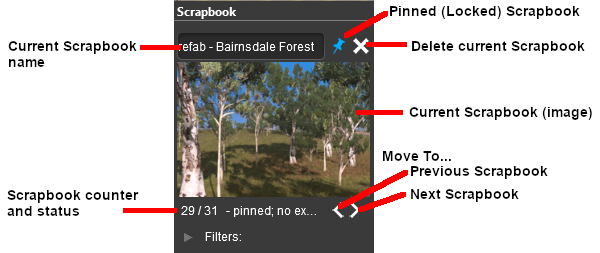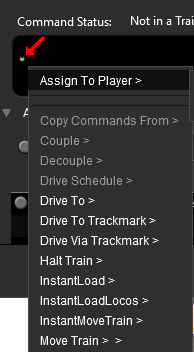The information in this Wiki Page applies to the palettes found in Trainz Plus Surveyor (Surveyor 2.0) and in Driver.
The original reference material for this document can be found at  Surveyor 2.0 Overview
Surveyor 2.0 Overview
| When you start Trainz Plus the world presented will look something like the following images, but what you actually see can be highly customised to your own preferences. |
Surveyor 2.0
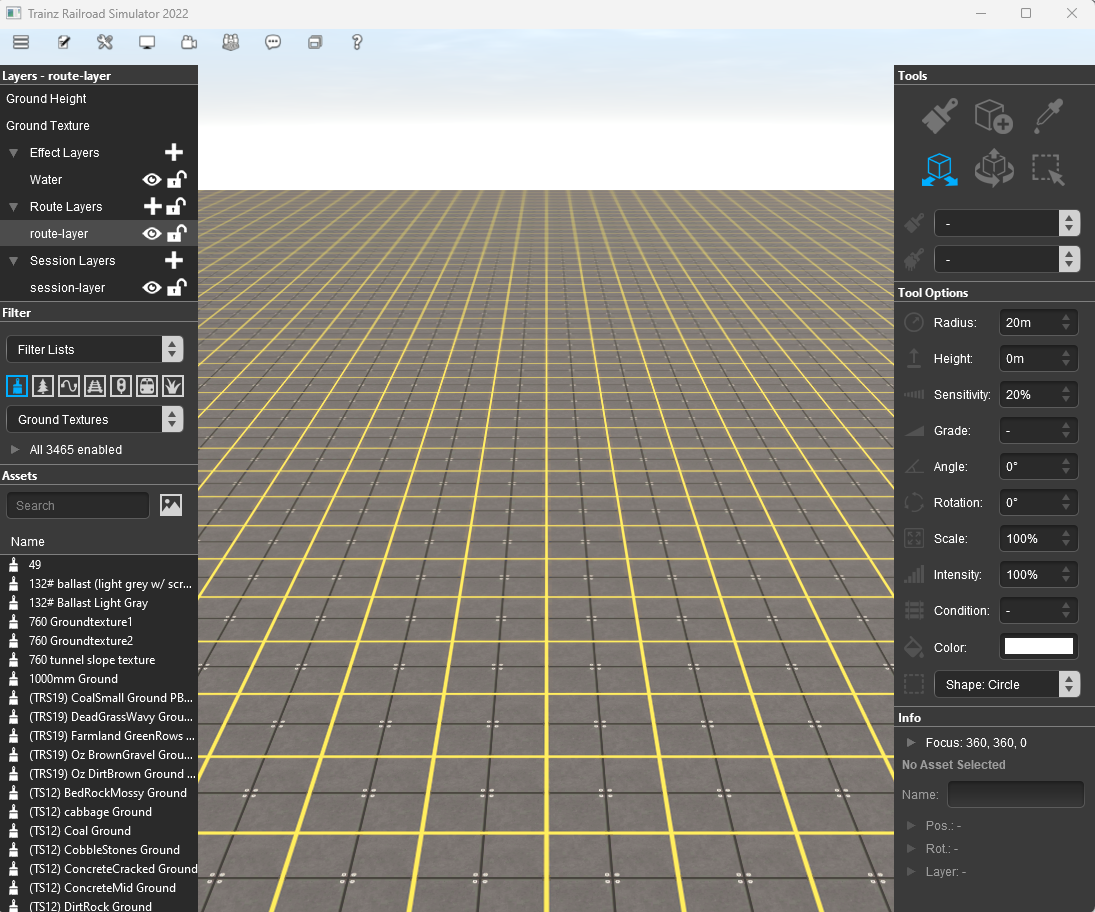
| The dark grey strips on the left and right of the screen contain Palettes that have been Docked into the positions shown. Palettes are where selections can be made, information displayed and controls set. |
| Shown in the image above are 5 Palettes from top left to bottom right:- |
 |
Assets |
 |
Layers |
 |
Info |
 |
Tools |
 |
Tool Options |
|
|
Not shown are 5 more Palettes that have been hidden from view:-
 |
Scrapbook |
 |
Asset Preview |
 |
Content Packages |
 |
Logs |
 |
Drivers |
|
|
|
Driver
All palettes in Driver are normally hidden.
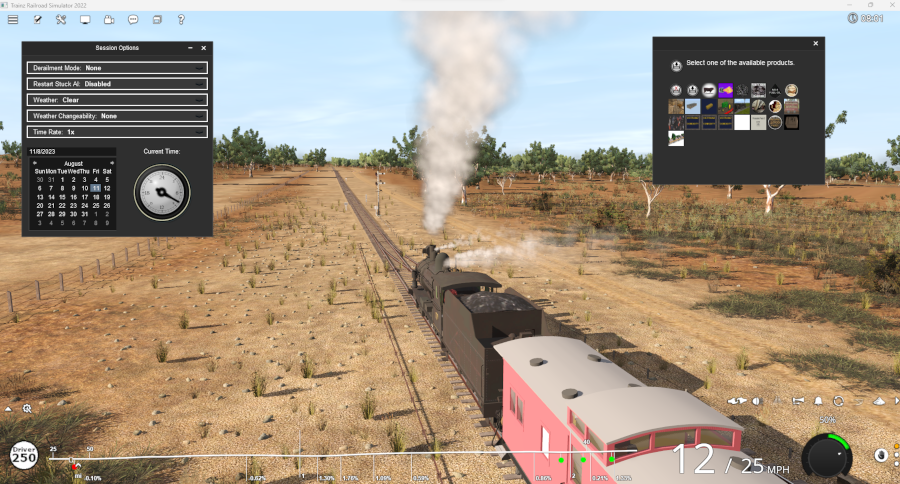
| Shown in the image above are 2 Palettes:- |
 |
Session Options |
 |
Commodity Picker |
|
|
Not shown are 4 more Palettes:-
 |
Session Info |
 |
Driver Control Centre (the Surveyor Drivers Palette) |
 |
Waybills |
 |
Schedule Info |
|
|
|
Hiding and Showing Palettes
 |
Palettes, in both Surveyor and Driver, are hidden and revealed using the Window Menu. |
 |
Trainz will save the visible/hidden state of each palette when you close the program. When you restart each palette will be returned to that last saved state. |
|
The visible and hidden Palettes in the screenshot shown above have had their visibility set by:-
Docking and Undocking Palettes
 |
Palettes in Surveyor are normally Docked, locked into fixed positions on both sides of the Surveyor Screen. They can be Undocked and freed to move anywhere on the screen. |
 |
Palettes in Driver are Undocked and are free to move anywhere on the screen. They cannot be Docked. |
 |
Trainz will save the docked/undocked state of each palette in Surveyor when you close the program. When you restart each palette will be returned to that last saved state. |
|
Undocking a Palette
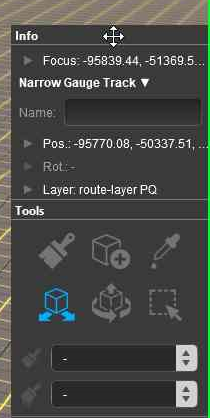 |
| Steps: To Undock a palette from its docked position on either side of the screen:- |
 |
Move the mouse pointer onto the Title Bar of the palette to be undocked. The pointer will take the shape of a 4 headed arrow |
|
|
|
|
Docking a Palette
Resizing Palettes
 |
Only Surveyor palettes that are Undocked can be resized. Some palettes have to be resized to display all their available information. |
 |
Driver palettes cannot be resized. |
 |
Trainz will save the docked/undocked state of each palette in Surveyor when you close the program. When you restart each palette will be returned to that last saved state. |
|
 To hide an Resized palette and later return it to the same Undocked and Resized state, Left Click on its Minimise - icon on its top menu bar. To restore it to the screen see the next section To hide an Resized palette and later return it to the same Undocked and Resized state, Left Click on its Minimise - icon on its top menu bar. To restore it to the screen see the next section  Minimise Maximise Close. Minimise Maximise Close. |
|
Minimise Maximise Close
 |
Minimising will hide a palette or window but retain its size and position data. |
 |
Maximising will return it to the screen using its last size and position data. |
 |
Closing will hide it but its size and position data will be lost. When next displayed it will be shown docked to the side of the screen. |
 |
Notes:
|
 |
All Surveyor palettes can be minimised |
 |
Only two Driver palettes can be minimised:-
 |
Session Options, and |
 |
Driver Control Center |
|
|
|
The image below shows a Surveyor 2.0 screen with an open window box (the Find Object Tool) and two Undocked palettes (Info and Layers)
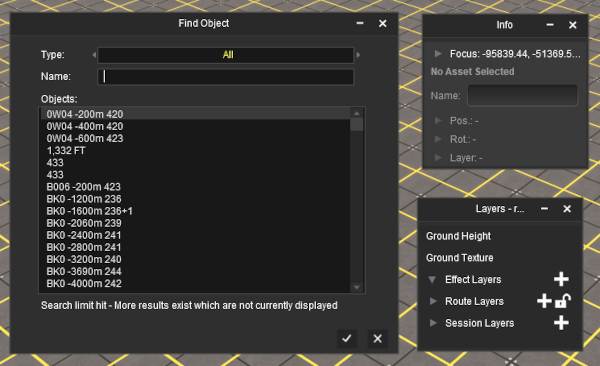 |
Each of the windows and palettes shown can be:-
Options: |
 |
individually Minimised by a Left Click on the - icon in each of their top menu bars |
 |
individually Closed by a Left Click on the x icon in each of their top menu bars
|
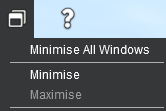 |
 |
simultaneously Minimised in a single action from the  Surveyor Window Menu by selecting Minimise All Windows Surveyor Window Menu by selecting Minimise All Windows |
|
 |
Minimising will "remember" the size and position of the palette or window while Closing will not |
|
|
|
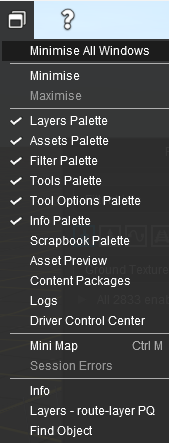 |
 |
Notes:
A Left Click on the  Window Menu will list all the palettes, visible and hidden, plus any minimised palettes and windows. Window Menu will list all the palettes, visible and hidden, plus any minimised palettes and windows. |
 |
In the image shown on the left the minimised windows are listed at the bottom of the menu list in the Minimised Windows Area as Find Object, Info and Layers. Layers is also shown with the name of the currently selected layer. |
 |
Note that the Layers and Info palettes are listed twice - once with a  icon in the Palette Area, which indicates that they are "active", and again in the Minimised Windows Area at the bottom, which indicates that they are "active" but "minimised". icon in the Palette Area, which indicates that they are "active", and again in the Minimised Windows Area at the bottom, which indicates that they are "active" but "minimised". |
| Steps: To Maximise a palette or window:- |
 |
Left Click on its name or title in the Minimised Windows Area at the bottom of the list. |
| |
 |
Warning:
DO NOT click on the name of the palette shown with the  icon in the upper Palettes section - this will reset it so it will become hidden (not just minimised) and it will lose its size and position data. icon in the upper Palettes section - this will reset it so it will become hidden (not just minimised) and it will lose its size and position data. |
|
|
|
|
This is a Surveyor Only palette
If the Info Palette is not visible on the screen then refer to  Hiding and Showing Palettes at the top of this document. Some Info Palette functions will also require the Assets Palette and the Tool Options Palette. Hiding and Showing Palettes at the top of this document. Some Info Palette functions will also require the Assets Palette and the Tool Options Palette.
|
|
| This palette can be easily overlooked but it has some very useful features:- |
 |
naming objects |
 |
providing precise data and control over the "focus" - the position of the cursor |
 |
providing precise data and control over the position and orientation of objects (it can be used instead of the Free Move Tool and the Fine Adjustment Tool) |
 |
identifying and setting the "home" layer and binding layer of a selected object |
 |
used for locking and unlocking a selected objects layer |
The components of the Info Palette are identified in the image below.
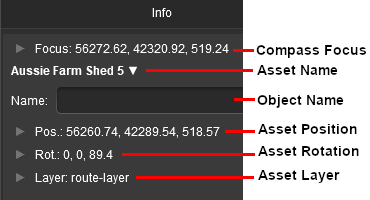 |
Every item in the palette can be edited.
Each of the small arrowhead icons in the palette will open to display more information and controls or a drop down menu of options. |
Palette Coordinates
|
 |
 |
|
|
|
|
All the Focus, Position and Rotation settings have drop down menus that allow values to be transferred to and from other settings and other tools.
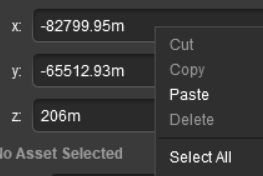
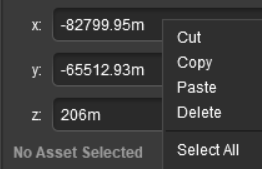 |
| Steps: |
 |
Right Click inside an Info Palette setting box |
| The first time the popup menu is opened it will only show two active options - Paste and Select All. |
| Paste |
will paste the contents of your Operating System (Windows, MacOS) clipboard into the setting. If data is already present then the new data will be added to it, not replace it |
|
| Select All will highlight the contents of the selected setting. You can also achieve this with a Left Click and Drag across the contents of the setting |
|
 |
Right Click inside the same Info Palette setting box |
| Once the value in a setting has been selected (highlighted) the popup menu will show all options as active. |
| Cut |
will copy the contents of the selected setting into your Operating System clipboard. The contents will then be deleted from the setting |
|
| Copy |
will copy the contents of the selected setting into your Operating System clipboard without deleting it |
|
| Delete will delete the contents of the selected setting. You can also achieve this with a Left Click and Drag across the contents and then press the Delete key |
|
|
|
Next to the z co-ordinate in both the Focus and Position is a small white down arrowhead. Left Click on the arrowhead to open its menu.
 |
There is only one option in the sub-menu.
| Left Click on the Use Height for Brush option to copy the current z value to the Tool Options Palette Height setting. |
|
|
Focus Info and Controls
|
 |
 |
|
|
|
|
 |
The Focus shows the current position and height of the Cursor object. |
Open up the Focus by a Left Click on its arrowhead icon.
 | Before changing the cursor position with the Focus controls, set a Bookmark at its current position.
|
|
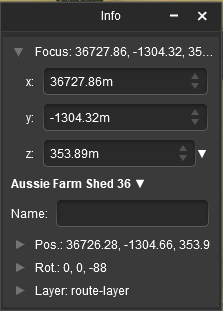 |
The current cursor position is shown in the x, y and z text boxes. These values can be edited to move the cursor to a new position but CARE will be needed.
 |
On the right of each data entry box is a pair of Up/Down arrow controls. Left Click and Drag up or down on these to adjust the position in smaller increments down to centimetres |
|
 |
Notes:
If you enter an x or y value that is "out in empty space" (beyond the edge of a boundary baseboard) then the cursor will be refocused at a point on the baseboard edge that is the closest to the entered co-ordinates.
|
|
|
 | If it has not been deleted you can identify the original (first) baseboard by entering 0 as the Focus x and y co-ordinates |
|
 |
"Asset Name" refers to the name of the asset as displayed in the Assets Palette and in Content Manager. This is not the same as the Object Name (see the next section) |
You must have an object (or objects) selected for an Asset Name to be shown and for this menu to be available.
 |
If more than one object has been selected then the name and position data shown will be for the last selected object. If different objects (with different kuid codes) have been selected then a count of the additional objects will be added. The (+2) shown in the object name in the image on the left indicates that 2 additional different objects are in the group of selected objects. |
Next to the Asset Name is a small white Down Arrowhead. Left Click on the arrowhead to open its menu.
 |
| Asset Name Menu Options |
| Copy |
NOT WORKING (a known bug) - copies the assets text details into your Operating System Clipboard for pasting, for example, into a text editor |
|
| Show Asset Details |
opens a new window showing the image and description of the selected object |
|
| List Assets in New Window |
opens up Content Manager and lists all the selected objects |
|
| Add to Picklist |
adds selected objects to a Picklist |
|
| Remove from Picklist |
removes selected objects from a Picklist (objects must already be in a Picklist) |
|
| Select in Assets Palette |
selects and highlights the selected object in the Assets Palette |
|
|
|
Object Name
|
 |
 |
|
|
|
|
 |
"Object Name" refers to the name that you give to an object |
| You can give any object in your Trainz World an identifying name. In some cases a name is vital for AI and session operations, in other cases it will be needed as a display feature - for example: to be shown on a station nameboard. You must have the object (or objects) selected for this option to be available. If more than one object has been selected then only the last object (the one with the Context Icon) will be affected |
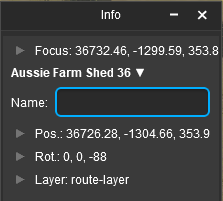 |
| Steps: To name (or rename) an object:- |
 |
Left Click inside the Name text entry box |
 |
Enter a name |
 |
Press the Enter key |
|
|
Position Info and Controls
|
 |
 |
|
|
|
|
You must have an object (or objects) selected for the position data to be shown and edited. Open up the position data by a Left Click on its Pos: arrowhead icon.
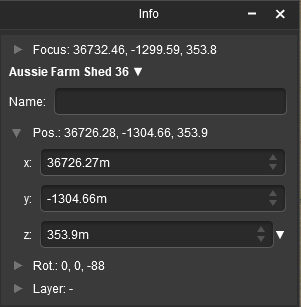 |
The position of the selected object (or the last object if more than one is selected) is shown in the x, y and z text boxes. These values can be edited to move the object or objects to a new position but CARE will be needed.
 | On the right of each data entry box is a pair of Up/Down arrow controls. Left Click and Drag up or down on these to adjust the position in smaller increments down to centimetres |
|
 |
Notes:
If you enter an x or y value that is "out in empty space" (beyond the edge of a boundary baseboard) then the objects will be moved to that position and may vanish from view. The Undo command can be used to reverse the move or the Marquee Tool can be used to add a baseboard under the "floating" objects. |
|
|
Rotation Info and Controls
|
 |
 |
|
|
|
|
You must have an object (or objects) selected for the rotation data to be shown and edited. Open up the rotation data by a Left Click on its Rot: arrowhead icon.
Layer Info and Controls
|
 |
 |
|
|
|
|
You must have an object (or objects) selected for the layer data to be shown and edited. Open up the layer data by a Left Click on its Layer: arrowhead icon.
 |
Notes:
|
 |
the Info Palette is best used to show and edit the layer and binding layer assignments of individual selected objects |
 |
operations such as creating, deleting, merging, renaming, moving and hiding layers are performed using the Layers Palette |
 |
layers can be Locked and Unlocked using the Info Palette or the Layers Palette but the Layers Palette is often the better choice for these tasks |
|
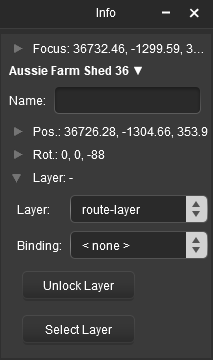 |
This will show the:-
 |
current layer assigned to the selected object |
 |
its assigned Binding Layer (if any) |
 |
the Locked or Unlocked state of the assigned layer |
| |
 Layer is currently Unlocked. Click this button to Lock the layer Layer is currently Unlocked. Click this button to Lock the layer |
| |
 Layer is currently Locked. Click this button to Unlock the layer Layer is currently Locked. Click this button to Unlock the layer |
| |
Using this button will also change the Locked or Unlocked padlock icon shown next to the layer name in the Layers Palette
 |
 |
Notes:
 |
Objects in a Locked Layer cannot be deleted or moved |
 |
Locked Layers can be deleted, moved and merged with other layers |
|
|
|
|
|
Assigning Objects to a Different Layer
|
 |
 |
|
|
|
|
A selected object or group of selected objects can be assigned to a different layer. If multiple objects have been selected then they do not have to all be in the same layer.
 |
The Active Layer is the layer used by the Placement Tool when objects are added to your Trainz World. This button gives you the opportunity to set the Active Layer to the same layer that you just used to assign to an object. Its use is optional. |
 | You can also set the Active Layer by selecting its name from the list in the Layers Palette. |
|
| Options: To set current layer to the Active Layer:- |
 If the Select Layer button is greyed out If the Select Layer button is greyed out |
 |
then the selected object is now assigned to the current Active Layer so there is no need to use this option |
 If it is NOT greyed out If it is NOT greyed out |
 |
then the selected object is now assigned to a layer that is not the current Active Layer. Left Click on the Select Layer button to switch the Active Layer to the same layer as the object
|
|
Assigning Objects to a Binding Layer
|
 |
 |
|
|
|
|
 |
The Binding Layer, or Bound Layer as it is also called, is a tool used in the development of your Trainz World. It allows you to temporarily assign an object to a second layer while it is still in its original layer. The object will then take on the properties (Locked or Unlocked, Hidden or Visible) of both layers. |
Assigned
Layer |
|
Binding
Layer |
|
Object
Status |
|
 Unlocked Unlocked |
 or None or None |
 Unlocked Unlocked |
 LOCKED LOCKED |
 or or  or None or None |
 LOCKED LOCKED |
 Unlocked Unlocked |
 LOCKED LOCKED |
 LOCKED LOCKED |
|
 Visible Visible |
 or None or None |
 Visible Visible |
 HIDDEN HIDDEN |
 or or  or None or None |
 HIDDEN HIDDEN |
 Visible Visible |
 HIDDEN HIDDEN |
 HIDDEN HIDDEN |
|
|
| In Summary:- |
 |
If the Assigned Layer or the Binding Layer of an object is Locked then the object will be Locked |
 |
If the Assigned Layer or the Binding Layer of an object is Hidden then the object will be Hidden |
 |
Notes:
|
 |
Objects in a Hidden Layer cannot be seen and therefore, cannot be selected, deleted or moved |
 |
The Layers Palette is the ONLY way to create, delete, name and hide layers |
|
|
Some examples of using the Binding Layer:-
Example 1: |
| The problem: |
You need to stop an object from being selected so that you can you move other objects on or around it |
| The solution: |
Use the Layers Palette to create a new empty layer and lock it. Set the Binding Layer of the object to the new locked layer. The object will then be locked so it cannot be selected or moved even though its original layer is unlocked. When the edit has been completed delete the empty locked layer you just created to unlock all its bound objects and remove all their bindings
|
| Example 2: |
| The problem: |
A group of objects (e.g trees) are blocking access to another object. |
| The solution: |
Use the Layers Palette to create a new empty layer and hide it. Set the Binding Layer of the blocking objects to the new hidden layer. The blocking objects will no longer be visible and cannot be selected even though their original layer is still visible. When the edit has been completed delete the empty hidden layer you just created to make all its bound objects visible and remove all their bindings
|
|
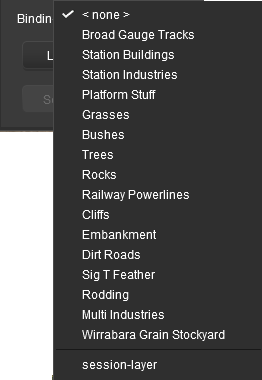 |
| Steps: To change the assigned binding layer of an object or group of objects:- |
 |
Left Click on the Binding drop down box. For a single selected object only the binding layer (which may be <none>) will be shown with a  in front of its name in front of its name |
 |
Select the Binding layer name from the drop down list. Note: the objects assigned layer will not appear in the list because an object cannot be bound to its own layer |
| The layer reassignment will start the instant the layer is selected |
 |
If you see a Debugging Window on the screen as the task is processed, it will inform you when the task has been completed. You can then close the window |
|
|
| As an example, the image below shows what you will see for a single object that has had:- |
 |
 |
its assigned layer changed (in the example from "route-layer" to "Station Industries") |
 |
its binding layer set (in the example to "Multi Industries") |
 |
the newly assigned layer is not locked so you have the option to lock it |
 |
the newly assigned layer is not the Active Layer so you have the option to make it the Active Layer |
|
 |
More information on creating, editing and using Layers can be found on the Trainz Wiki at:-
- How to Use Layers
|
This is a Surveyor Only palette
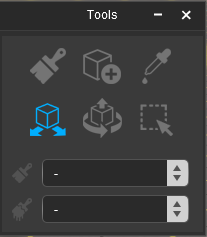 |
 |
The Tools Palette is at the core of the new interface and takes the place of all the Tool Flyouts that have been the standard for Trainz Surveyor for many years. Some of the tools are new while others have been given a makeover and new abilities. The tools manipulate the Surveyor World you see in many different ways.
|
|
 |
The Context Tool is attached as an icon to a selected or newly placed object. The icon and its Context menu will vary according to the type of object. |
Various brush tools make use of the Tool Options Palette, the Assets Palette, the Info Palette, the Layers Palette and the Scrapbook Palette. If a palette required by one of the brush tools is not visible on the screen then refer to  Hiding and Showing Palettes at the top of this document. Hiding and Showing Palettes at the top of this document.
|
|
The Brush Tool
 |
Keyboard Shortcut: W |
The Brush Tool "paints" the ground height, ground textures, effect layers and scrapbook scenes in a Trainz World |
| The Brush Targets Ground Height , Scrapbook Data and Effect Layers have a second drop down menu that controls the Brush Action. |
The Placement Tool
 |
Keyboard Shortcut: E |
The Placement Tool adds objects to a Trainz World |
The Eyedropper Tool
 |
Keyboard Shortcut: R |
The Eyedropper Tool identifies and selects objects in a Trainz World |
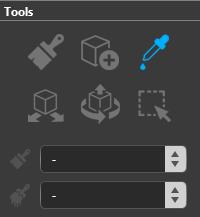 |
 |
The Eyedropper is also inside all the tools in this palette so you can quickly identify any object without having to switch to the Eyedropper Tool and back again. Hold down the Alt key to activate this feature in other tools
|
|
|
The Free Move Tool
 |
Keyboard Shortcut: S |
The Free Move Tool moves objects around a Trainz World |
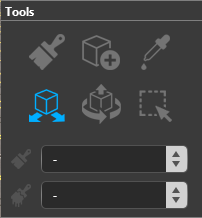 |
 |
Notes:
The Free Move Tool can move any selected object or objects (except Ground Textures and Effect Layers) in any direction horizontally. Vertical movements can be achieved by using the Height control in the Tool Options Palette.
|
|
|
|
The Fine Adjustment Tool
 |
Keyboard Shortcut: D |
The Fine Adjustment Tool makes 3D adjustments (XYZ position and rotations) to objects in a Trainz World |
The Marquee Tool
 |
Keyboard Shortcut: F |
The Marquee Tool selects the content in areas of a Trainz World, creates and deletes baseboards and sets their properties. It can also be used in creating Scrapbooks |
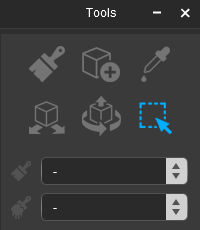 |
The Marquee Tool draws out a rectangular area, the Marquee Selection Area, in the Trainz World. Any objects (including Ground Heights, Ground Textures and Effect Layers) that are inside the Marquee Selection Area or touched by its boundary will be selected. The contents of the area can then be moved, rotated, deleted or copied to a Scrapbook.
 |
The Marquee Tool can also draw an area outside the boundaries of a Trainz World to add new baseboards. |
|
This is a Surveyor Only palette
 |
This palette is used by various tools to set controls and parameters. For a detailed description of all the options presented by the Tools Palette for the different tools, see the Trainz Wiki page  How to Use the Surveyor 2.0 Tools How to Use the Surveyor 2.0 Tools |
| All the Tool Options controls and settings are shown in the image below. The controls are shown in the image as being "inactive". An "active" control will have its icon (to the left of the control name) shown in Gold . Different Brush Types and Brush Actions will activate different controls. |
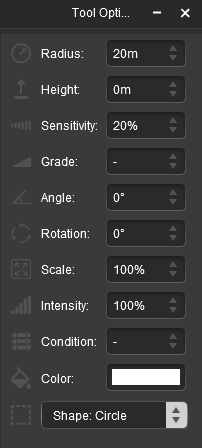
 |
On the right of each data entry box is a pair of Up/Down arrow controls. Left Click and Drag up or down on these to adjust the value in smaller increments |
|
|
| Radius |
All Brushes the brush radius (metres) |
| Range: |
5m and above for 5m and 10m grid resolutions
0.125m and above for HD Terrain
For Effect Layers the minimum brush size will vary. See Notes: below |
|
| Height |
Set Ground Height Water Effect Layer Object Placement the brush or object height (metres) |
|
|
| Sensitivity |
All Ground Heights Ground Textures Scrapbook Data Water Effect Layers the rate at which the ground height/water layer is raised/lowered or the texture being "painted" becomes visible |
| Range: |
1% (very slowly) to
100% (very quickly) |
|
| Grade |
Ground Height Grade Water Effect Layer Spline Object Placement the slope of the ground, spline or water effect layer |
| Range: |
0% (flat) to
±100% (steep but not vertical) |
|
| Angle |
Ground Height Grade Water Effect Layer grade direction (compass degrees) |
| Range: |
0° (North) to ±359°
a negative value reverses the grade direction |
|
| Rotation |
Ground Textures Scrapbook Data initial rotation angle (degrees) |
|
|
| Scale |
Ground Textures Scrapbook Data (Clone Brush) the brush scaling factor |
| Range: |
0.01% = smallest to
100% = full size to
>100% larger than full size |
|
| Intensity |
TurfFX & Clutter Effect Layers the effect layer density within the brush area |
| Range: |
1% (almost none) to
100% (maximum) |
|
| Condition |
Track Spline Object Placement sets the track condition (or "ride comfort") for each segment |
| Range: |
1% (terrible track condition) to
50% (average track condition) to
100% (perfect track condition)
|
|
| Shape |
Scrapbook Data brush shape |
| Options: |
 |
Circle and Square will set the brush to the selected shape
Natural will set the brush to the same shape as the Marquee that created the scrapbook, which may be rectangular |
|
|
|
 |
Notes:
|
 |
Unlike Surveyor Classic, there is no upper limit to the brush Radius . Brushes of hundreds of metres (even kilometres) in size are possible. However, the program performance will decrease as the brush radius increases. If you are using the brush to set an entire baseboard, or many baseboards, to a specific height then the Marquee Tool would be a better choice. |
 |
The Grade is defined as vertical rise divided by horizontal distance converted to a percentage figure. So a grade of 100% (the maximum allowed) would mean a slope formed by the height and distance both being the same value (e.g. a height increase of 50m over a distance of 50m). A vertical slope (e.g. a cliff) would have an infinite grade which is currently impossible in Surveyor. |
 |
The Rotation controls the starting angle for placing a scrapbook or a texture when painting and is often used to avoid pattern repetition. As in Surveyor Classic, holding down the [ or ] keys while painting a texture will continuously change the rotation angle |
 |
For TurfFX and Clutter effect layers the minimum brush Radius will depend on the configuration settings (asset density, resources used, etc) of the layer that is being painted. If the Radius setting is below the minimum for the selected layer then the brush circle will turn red and it will not paint |
 |
 |
Warning:
Setting extreme values for the Scale and the Radius when using the Scrapbook Data Clone Brush can cause performance issues (i.e. long delays) while the program attempts to scale and clone the scrapbook contents |
|
|
|
|
 |
 |
|
|
|
|
 |
Most of the data entry boxes in the Tool Options Palette have a Popup Menu. Right Click inside a box to bring up its menu |
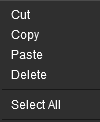 |
| Tool Popup Common Options for Radius Angle Sensitivity Rotation Scale Intensity |
| Cut |
copies and deletes the highlighted value in the data entry box into your Operating System (Windows, MacOS) clipboard |
| Copy |
copies the highlighted value in the data entry box to your Operating System clipboard |
| Paste |
copies the value from your Operating System clipboard into the data entry box |
| Delete |
deletes the highlighted value in the data entry box |
| Select All |
selects (highlights) the current value in the data entry box |
|
|
 |
Highlight the value in the text box (use a Left Click and Drag over the data entry or Left Click the Select All option first) before choosing the Cut , Copy or Delete options above |
|
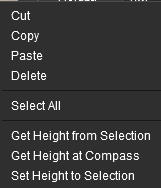 |
| Tool Popup Options for Height |
| All of the Tool Popup Common Options above plus ... |
| Get Height from Selection |
copies the Height value of the Selected Object and places it into the data entry box |
| Get Height at Compass |
copies the Height value of the Compass Rose and places it into the data entry box. This is the Focus z value from the Info Palette |
| Set Height to Selection |
applies the Height value to the Selected Object |
|
|
 |
| Tool Popup Options for Grade |
| All of the Tool Popup Common Options above plus ... |
| Get Grade from Selection |
copies the Grade value of the Selected Object and places it into the data entry box |
| Set Grade to Selection |
applies the Grade value to the Selected Object |
|
 |
The Grade setting only applies to Spline Objects, Ground Heights (Grade) and Water Effect Layers
|
|
|
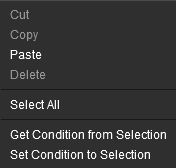 |
| Tool Popup Options for Condition |
| All of the Tool Popup Common Options above plus ... |
| Get Condition from Selection |
copies the Condition value of the Selected Track Spline and places it into the data entry box |
| Set Condition to Selection |
applies the Condition value to the Selected Track Spline |
|
 |
The Condition setting only applies to Track Spline Objects
|
|
|
Tool Options Active Controls
|
 |
 |
|
|
|
|
 |
Different Tool Palette and Brush Type selections will activate different option controls |
Some examples of when the controls will become active are:-
 |
If a Brush Tool is selected then the exact controls that will be active will vary between the different brushes and brush actions. For example, selecting the Ground Height Brush and the Set Height brush action will active the following Tool Options. |
 |
| Radius |
the brush radius (metres) |
| Range: |
5m and above for 5m and 10m grid resolutions
0.125m and above for HD Terrain |
|
| Height |
the exact height, in metres, that the ground will be raised (or lowered) to |
|
|
| Sensitivity |
the speed at which the ground height will be changed |
| Range: |
1% (very slowly) to
100% (very quickly) |
|
 |
On the right of each data entry box is a pair of Up/Down arrow controls. Left Click and Drag up or down on these to adjust the value in smaller increments |
|
|
|
 |
If a Track Spline Object is selected with the Free Move Tool or the Fine Adjustment Tool then the following Tool Options will become active. |
 |
If the Scrapbook Data Brush is selected to paint the current Scrapbook into the Trainz World then certain controls that will affect the painting of the Scrapbook will, depending on the brush action selected, become active. |
This is a Surveyor Only palette
 |
This palette is used by various tools and other palettes to select and identify assets and objects. It includes a filter function to narrow down the search and selection process. |
Using the Asset Filters
 |
The Assets Palette provides filter options that can be used with the Placement Tool, Free Move Tool, Fine Adjustment Tool, Marquee Tool and the Eyedropper Tool. |
 |
When used with the Eyedropper - either the Eyedropper Tool (press R ) or the Eyedropper Icon (press and hold down Alt ) - the filters can be used to restrict the eyedropper to only "seeing" and selecting certain objects or types of objects. |
|
Steps:
 The first filter option controls where the filters are applied.
The first filter option controls where the filters are applied.
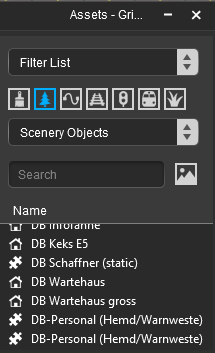 |
The top drop down box will provide three actions:-
 |
Filter List |
 |
Filter Selection |
 |
Filter Visibility |
|
 |
|
These actions can affect the display and selection of objects in the Trainz World
| Asset Filter Options: |
| Filter List |
this action will have no effect on the operation of the tool selected in the Tool Palette or on the objects displayed on the screen in the Trainz World. It is the default setting and the search results of the entered filters will be shown in the Assets Palette asset name list below the filters. |
|
| Filter Selection |
this action will restrict the selected tool (e.g. The Placement Tool) to only working on those objects that are in the filtered list. Objects that are not in the filtered list will still be visible in the Trainz World but cannot be selected. |
|
| Filter Visibility |
this action will hide all objects in the Trainz World that are not in the filtered list. The only exceptions are Ground Textures and Effect Layers which will be visible but, unless they are also in the filtered list, cannot be selected. |
|
|
|
|
 |
It is recommended that you also make use of either Step  or Step or Step  or BOTH or BOTH  and and  as described below. as described below.
|
 |
The second filter is optional and identifies the type of asset that will be selected by the filter.
This option can be selected by a Left Click on a icon that represents the different types of assets or selecting the type of asset from a drop down list. |
Options: Choose from:-
 Left Click on an asset selection icon Left Click on an asset selection icon |
 |
 |
all ground textures |
 |
all non-spline scenery assets |
 |
all spline scenery assets |
 |
all track spline assets |
 |
all track (non spline) assets (signals, etc) |
 |
all rolling stock assets |
 |
all Effect Layer presets |
|
|
|
OR |
|
 |
The third filter is also optional. You can enter a string of text characters that will be used to search the asset names and their descriptions for a match. Those assets that return a positive match, together with a positive asset type, will be shown in the filter name list. |
 |
The String Search will accept a list of <kuid> codes seperated by commas. This list can be created by Content Manager by selecting the assets followed by the List Assets in New Window option. Copy the assets list into your clipboard and paste it into the Assets Palette search box |
|
An example: To search for all Scenery Objects that have the text string "barn" in their name or description:-
Expanding the Assets Name List View
|
 |
 |
|
|
|
|
The list of asset names shown below the filter controls can be expanded to provide more information about each asset.
 |
If you hide or dock the Assets Palette after resizing, then it will return to its original dimensions. To hide the palette so that its new size and position will be restored when it is made visible again, Left Click on its Minimise - icon on its top menu bar. See  Minimise Maximise Close at the top of this document. Minimise Maximise Close at the top of this document. |
|
Thumbnail View
|
 |
 |
|
|
|
|
As an alternative to the list view of filtered assets, there is a 3D thumbnail view option. Again this works best when the Assets Palette has been undocked.
 |
Notes:
 |
the 3D thumbnails are created from the 3D mesh data in each asset. The thumbnail.jpg image, which may be a generic image for a large number of similar assets or give a very uninformative view, is not used. |
 |
If the asset is animated then its animation will play in the thumbnail. |
|
|
This is a Surveyor Only palette
 |
This palette is used to manage layers, both object (route and session) and effect (TurfFX, clutter and water) layers |
 |
It can create, rename, merge, delete, move, hide/show and lock/unlock layers and set the Active Layer |
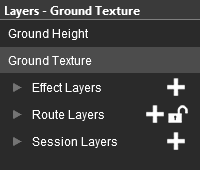 |
The Layers Palette will show all the layers in their groups (Effect, Route and Session) plus the Ground Height and Ground Textures special "layers". In the image on the left all the layer groups have been minimised (the arrowhead symbol to the left of each group name is pointing to the right).
 |
The Route Layers group, along with the Ground Height, Ground Textures and Effect Layers, are saved and loaded with the Route |
 |
The Session Layers group, along with any Session Rules and commodity settings, is saved and loaded with the Session. A Session Layers group, but one without any stored objects and using the Session default settings, will always be present when a Route is loaded without a Session |
|
Lock the Route Layer Group
 |
All the Route Layers can be locked against accidental alteration. |
The Route Layers group has a open padlock icon next to its name - shown as  (unlocked).
(unlocked).
| Steps: To lock/unlock all the Route Layers:- |
 |
Left Click on the unlocked (open padlock) icon to lock ALL the Route Layers
The icon will change to  (locked) (locked) |
 |
Left Click on the locked (closed padlock) icon to unlock ALL the route layers
The icon will change to  (unlocked) (unlocked) |
|
Open a Layer Group
|
 |
 |
|
|
|
|
To the left of each group name is a small arrowhead pointing to the right. Left Click on the arrowhead to open up the group.
Add a New Layer
 |
You cannot create new layer groups but you can add new layers to a existing group. |
Each layer group has a  icon next to its name. Left Click on the icon to add and name a new layer to that group. If you are adding a new Effect Layer then you will also have to identify the type of effect - TurfFX, Clutter or Water. icon next to its name. Left Click on the icon to add and name a new layer to that group. If you are adding a new Effect Layer then you will also have to identify the type of effect - TurfFX, Clutter or Water. |
Renaming a Layer
|
 |
 |
|
|
|
|
 |
| Steps: To rename a layer:- |
 |
Right Click on a layer name and select Rename Layer.. from the popup menu. You cannot rename a Layer Group. |
 |
You will be asked to enter a new name for the layer. |
|
|
Deleting a Layer
 |
Warning: Deleting a Layer will delete every object that has been assigned to that layer
|
|
 |
| Steps: To delete a layer:- |
 |
Right Click on a layer name and select Delete Layer from the popup menu. You cannot select a Layer Group name to be deleted.
You will be given a warning that you are about to delete a layer. |
 |
if you confirm the delete order then the layer and ALL OF ITS CONTENTS will be deleted |
 |
depending on the contents of the layer and the size of the Trainz World, the process may take some time. You will be shown a progress bar in a message window during the delete operation |
| |
 |
 |
when the message Operation complete, layers updated successfully appears close the message window |
| The deleted layer and its contents can be restored (after the delete has completed) using the Ctrl + Z keys
|
|
|
Moving a Layer
|
 |
 |
|
|
|
|
 |
Layers can be individually moved up and down within the same layer group or between the Route Layers and the Session Layers groups. |
 |
Notes:
|
 |
Warning: Moving layers between the Session Layers and the Route Layers groups will move the contents of those layers from one group to the other. This will change where the layers and their contents are saved (in the Route or in the Session)
|
|
 |
there is no advantage in moving a layer within the same layer group except if you are preparing for a layer merge operation (see Merging a Layer below) |
 |
layers in the Effect Layers group cannot be moved |
 |
layers from the other groups cannot be moved into the Effect Layers group |
 |
the Ground Height and Texture layers are special "single layer" groups, not groups of layers, and cannot be moved or have other layers added to them |
|
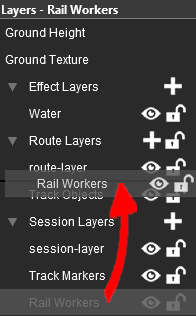
Moving the Rail Workers layer up one level |
| Steps: To move a layer:- |
 |
Left Click and Drag the layer name up or down to its new position. Note: You cannot move a Layer Group. |
 |
release the layer in its new position. |
 |
depending on the contents of the layer and the size of the Trainz World, the process may take some time. You will be shown a progress bar in a message window during the move operation |
 |
at the conclusion, hopefully, you will be shown a message "Operation complete"
 |
 |
close the progress message window |
| The move can be reversed (after it has completed) by using the Ctrl + Z keys
|
|
|
 |
Notes: Moving Layers - What Could Possibly Go Wrong? 😀
|
Well, a great deal it seems. You may get a different message during the layer move operation.
 |
| The most common error when moving layers is, as the message above states, an invalid hierarchy. This occurs when a layer is moved to an incorrect level for the type of objects it contains. It is Track Splines and Track Objects (e.g. signals, switches, speed signs, etc) that cause this problem. |
The situation that created the error messages shown above is shown in the image below left:-
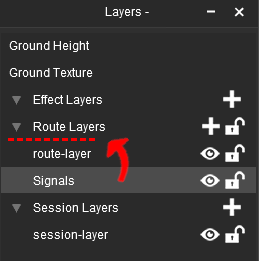 |
 |
all the track splines, the parent track identified in the error messages, are in the route-layer |
 |
track objects, in this case signals but any track objects could have been used, have been placed in the Signals layer. This layer, according to the order of the layers from the top to the bottom, is one layer below the route-layer that contains the track where the signals are attached. In this position, physically below the route-layer, the Signals layer and the track objects it contains will cause no problems |
 |
the Signals layer is being moved up to a position shown by the dashed red line. The new position, again according to the order of the layers from the top to the bottom, is one layer above the route-layer. |
 |
The final error message shown is confusing and, from a commonsense point of view, incorrect.
Trackside objects cannot be in a layer below the layer their track is in.
Best Advice: Ignore the word below and replace it with the word above so the message reads
Trackside objects cannot be in a layer above the layer their track is in.
|
|
|
Solutions to This Problem:
| Options: |
 |
use the route-layer to hold the track splines and never move any layer containing track objects, or any layer at all to be absolutely safe, above this layer OR |
 |
use the route-layer to hold the track splines and ALL track objects |
| Track objects such as Trackmarks and Triggers that are needed for a Session but not the Route can still be placed in the Session Layers group as long as the layer used remains in the Session Layers group |
|
|
|
Merging a Layer
|
 |
 |
|
|
|
|
 |
A layer can be merged with the layer immediately above it |
 |
| Steps: To merge two layers:- |
 |
Right Click on a layer name in the Layers Palette |
 |
select the Merge Layer Up option from the popup menu |
|
|
 |
Notes:
|
 |
the selected layer will be merged with the layer immediately above it |
 |
you may need to move the layer being merged into the correct position before the merge (see Moving a Layer above) |
 |
depending on the contents of the layer, the process may take some time. You will be shown a progress bar in a message window during the merge operation |
 |
the merged layers and their contents can be restored (after the merge has completed) back into two separate layers by using the Ctrl + Z
keys |
 |
layers in the Effect Layers Group cannot be merged. In place of Merge Layer Up the popup menu for an Effect Layer will have an Edit Layer option
|
|
Hiding Layers
 |
Each individual layer has an Eye icon that controls the state (visible or hidden) of that layer |
Left Click on the Eye icon to toggle its state between visible and hidden.
| If the Eye icon is:- |
 |
Open then layer is visible in both Surveyor and Driver |
 |
Closed then layer is hidden in both Surveyor and Driver |
|
 |
Notes:
|
 |
Hiding a layer will protect its objects from being selected, deleted and moved |
 |
New assets can be added to a hidden layer by confirming the action in a dialogue window which will make the layer visible |
 |
Objects can be assigned to a hidden layer using the Info Palette |
 |
Hidden layers can still be deleted, renamed, moved and merged |
|
|
|
Locking Layers
|
 |
 |
|
|
|
|
 |
Each individual layer has a Padlock icon that controls the state (locked or unlocked) of that layer |
 |
The Route Layers Group has a Padlock icon that controls the state (locked or unlocked) of ALL the Route Layers |
Left Click on the Padlock icon to toggle its state between locked and unlocked
| If the Padlock icon is:- |
 |
Open then layer is unlocked |
 |
Closed then layer is locked |
|
 |
Notes:
|
 |
Locking a layer will protect its objects from being deleted and moved |
 |
New assets can be added to a locked layer by confirming the action in a dialogue window which will unlock the layer |
 |
Objects can be assigned to a locked layer using the Info Palette |
 |
Locked layers can still be deleted, renamed, moved and merged |
|
|
|
Setting the Active Layer
 |
The Active Layer is the layer where new objects will be automatically added when using the Placement Tool |
 |
Only Route and Session layers can be selected as the Active Layer |
| The active layer is shown in the palette with its name on a Blue or Light Grey background. The name of the current Active Layer is also shown in the Layer Palette Title Bar. In the images below the Rail Workers layer from the Session Layers Group is the current Active Layer. |
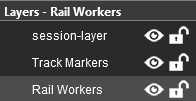 |
|
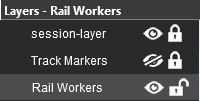 |
| Steps: To set a new Active Layer:- |
 |
Left Click on the layer name.
|
|
|
 |
You can also use the Info Palette to set the layer occupied by a selected object as the Active Layer |
|
Move an Object to Another Layer
|
 |
 |
|
|
|
|
 |
Use the Info Palette to move objects to another layer. |
This is a Surveyor Only palette
If the Scrapbook Palette is not visible on the screen then refer to  Hiding and Showing Palettes at the top of this document. Some Scrapbook Palette functions will also require the Tool Options Palette. Hiding and Showing Palettes at the top of this document. Some Scrapbook Palette functions will also require the Tool Options Palette.
|
|
 |
This palette manages the Scrapbooks that you have created yourself, installed from other sources (such as the DLS) or came installed with Trainz. It also controls which parts of a scrapbook are pasted or painted into the Trainz World.
|
 |
Notes:
|
| Scrapbooks, when created, will contain:- |
 |
Ground Heights |
 |
Ground Textures |
 |
Effect Layers - if present |
 |
Selected Objects - scenery items, splines, track, signals, etc |
 |
But NOT Rolling Stock (Trains) |
| Ground heights, textures and effect layers are always included in a scrapbook but you can control which scenery objects are added by manually selecting them or using the filter controls in the Assets Palette |
|
|
 |
Notes:
|
|
Scrapbooks, when painted or pasted, can contain any combinations of:- |
 |
Ground Heights |
 |
Ground Textures |
 |
Effect Layers |
 |
Scenery Objects (Meshes) - individual buildings, trees, signals, etc |
 |
Scenery Splines - roads, track, fences, etc |
| You have options that will control which of these data categories are transferred and how they are transferred from the scrapbook into the Trainz World. |
|
|
  |
Left Click on the pin icon to Lock (blue pin) and Unlock (white pin) the scrapbook. Locked scrapbooks are permanent (but can still be deleted). Unlocked scrapbooks will "expire" (self delete) after 5 days |
 |
Left Click on the delete icon to delete the current scrapbook - most scrapbooks can be deleted (see Notes: Deleting Built-in Scrapbooks below for the exceptions to this) |
 |
The thumbnail of the currently displayed scrapbook and the one that will be painted or pasted into the Trainz World |
 |
Identifies the currently displayed scrapbook (the first number) and the total number of stored scrapbooks (the second number) |
 |
Left Click on the < or > to move forwards or backwards through the stored scrapbooks to select the scrapbook that will be added to the Trainz World |
| |
The scrapbook name can be edited. Simply Left Click inside the name box to edit or replace the current name. Left Click on the image to make the name change permanent and pin (lock) the scrapbook |
|
|
 |
Notes: Deleting Built-in Scrapbooks
|
| Some scrapbooks are installed with Trainz and cannot be deleted. These scrapbooks have the label Prefab at the front of their names (you may have to scroll to the front of the name to see it). While they cannot be deleted they can be "disabled" so that they won't appear as an installed scrapbook. Unlocking them will not cause them to "expire" - after 5 days they will just become locked again. |
| Steps: To disable built-in scrapbooks |
 |
Open Content Manager and locate the "permanent" scrapbook or scrapbooks.
Search Tips: Name: starts with "Prefab"; Status: is Built-in; Type: is Misc |
 |
Highlight (select) the scrapbook assets individually or as a group |
 |
Open the Content menu and select the Disable option |
You can reverse this and enable any or all of these scrapbooks at any time if you need them. |
|
|
Creating a New Scrapbook
|
 |
 |
|
|
|
|
| A new scrapbook can be created by either:- |
| Options: |
 |
Individually selecting one or more objects OR |
 |
Drawing a Marquee Selection Area around one or more objects and:- |
| Then choose one of the following:- |
 |
press Ctrl + C to copy the selection to a new scrapbook OR |
 |
press Ctrl + X to cut the selection to a new scrapbook - the object or objects will be removed from the Trainz World OR |
 |
open the  Surveyor Edit Menu and select Cut or Copy Surveyor Edit Menu and select Cut or Copy |
 |
Notes:
|
 |
Rolling Stock Objects cannot be added to a Scrapbook |
 |
Regardless of how it is created, the ground height, ground textures and, if present, effect layers under the selected objects will always be added to the scrapbook. |
|
|
 |
You don't have to use the Marquee Tool to create a new Scrapbook. You can use the Free Move Tool or the Fine Adjustment Tool to select any number of objects and then press Ctrl + C . The selected objects, along with the ground height, ground textures, and any effect layers, will be copied into a new Scrapbook |
|
When a new Scrapbook is created by a Cut or Copy , it will appear in the Scrapbook palette with some basic details.
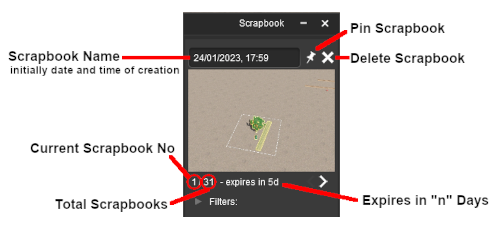 |
| The newly created scrapbook will be given:- |
 |
a name consisting of the date and time of its creation |
 |
a thumbnail |
 |
The thumbnail image will be taken using the current camera POV (point of view). Move the cursor position and zoom in/out to get the best possible shot of the Scrapbook objects before giving the Cut or Copy options
|
|
|
 |
a scrapbook number (it will be inserted as №1 scrapbook) |
 |
an expiry date which will be set 5 days after its creation - this will countdown each day until 0 when the new scrapbook will be deleted |
|
 |
Notes:
|
 |
Scrapbooks use very little memory so there is no real limit to how many you can store in the palette but finding the one you want will be more difficult as the list grows longer |
 |
Rolling Stock Objects cannot be added to a Scrapbook |
|
|
 |
 |
Most scrapbooks, old and new, can be deleted at any time by a Left Click on the Delete  icon. See Notes: Deleting Built-in Scrapbooks in the section above for the exceptions icon. See Notes: Deleting Built-in Scrapbooks in the section above for the exceptions |
 |
Deleting a Scrapbook after it has been pasted does not delete the objects that it has added to the Trainz World |
|
|
There are two changes that can be made to the new scrapbook:-
 |
Give it a name - Left Click inside the Name Text Box and type a new name. To set its new name Left Click on the image (pressing Enter does not work - a known bug) |
 |
Make it permanent - Left Click the white Pin icon ( ) to change it to blue. The scrapbook will no longer expire but it can still be deleted at any time ) to change it to blue. The scrapbook will no longer expire but it can still be deleted at any time |
Pinned scrapbooks are always shown with a blue pin icon  and the words "pinned, no expiry" displayed next to their scrapbook № and the words "pinned, no expiry" displayed next to their scrapbook № |
 |
The Pinning of any scrapbook can be reversed so that it will expire in 5 days time. Simply Left Click the blue pin icon to change it back to white. |
|
|
|
 |
 |
Once a scrapbook has been Pinned it becomes an asset and will appear in Content Manager |
 |
 |
Notes:
|
 |
If a Pinned scrapbook is deleted from the Scrapbook Palette then it will also be deleted as an asset from Content Manager |
 |
If a scrapbook asset is deleted (or disabled) in Content Manager then it will also be deleted from the Scrapbook Palette |
|
|
|
The scrapbook asset can be saved as a CDP file and uploaded to the DLS.
 |
You can archive your scrapbooks as CDP files to keep the number of installed scrapbooks to a minimum. If an archived scrapbook is needed then you can use the Import Content Files option in Content Manager to add it to the Scrapbook Palette. It can be deleted from the palette later, when no longer needed. |
|
Painting or Pasting a Scrapbook
|
 |
 |
|
|
|
|
Painting a Scrapbook
Existing Scrapbooks can be painted into the Trainz World using the Brush Tool (see the Trainz Wiki page  How to Use the Surveyor 2.0 Tools) or Pasted into the Trainz World. How to Use the Surveyor 2.0 Tools) or Pasted into the Trainz World.
When the Scrapbook Data Target is selected in the Brush Tool, a second drop down box will give a choice of two brush Actions that control how the scrapbook will be applied. |
 |
Notes:
|
Scrapbook Brush will resize the scrapbook contents to fit the selected brush shape and size.
 |
If the brush is small then the scrapbook contents will be compressed closer together |
 |
If the brush is large then the contents will be spaced further apart |
 |
Every Left Click will paste another complete scrapbook copy |
 |
The Scale setting in the Tool Options Palette is ignored. |
|
| Scrapbook Clone will paste the scrapbook sized according to the Scale setting (100% = original size)
|
|
 |
Tool Options Palette Controls |
 |
The active scrapbook brush options for each action are shown in the Tool Options Palette with a Gold coloured icon next to their names. Those options that have their icon greyed out will be ignored by the selected action, but they can still be edited. |
 |
Most of the data entry boxes in the Tool Options Palette have a Popup Menu (Right Click inside the box) that can be used to collect and distribute data - see the Wiki Page  How to Use the Surveyor 2.0 Palettes for more details. How to Use the Surveyor 2.0 Palettes for more details. |
|
 |
Notes:
|
 |
Unlike Surveyor Classic, there is no upper limit to the brush Radius . Brushes of hundreds of metres (even kilometres) in size are possible. However, the performance will decrease as the brush radius increases. |
 |
The Rotation controls the starting angle for pasting the scrapbook objects. In Surveyor Classic you could only rotate and paste in 90° increments. In S20 you can rotate and paste at any angle. |
 |
The Ground Height options in the Scrapbook Filters control how the terrain heights in the Scrapbook are applied |
 |
Take care if setting both the Scale and the Radius . Using extreme values for both, such as a very large brush radius and a very small scale value, can cause performance issues (i.e. long delays) while the program attempts to scale and clone the scrapbook contents |
|
|
Pasting a Scrapbook
| The current Scrapbook can be Pasted into the Trainz World at the cursor (the Compass Rose) position by either:- |
| Options: |
 |
pressing Ctrl + V , OR |
 |
selecting Paste from the Context Menu of a selected object |
| In both cases the scrapbook contents will be pasted using the original scrapbooks size. It will be pasted inside a Marquee Selection Area that can be moved and resized. The objects that are pasted and how they are pasted is controlled by the current Scrapbook Palette filter settings
|
|
Setting the Filters
 |
You will probably need to undock and resize the Scrapbook palette to make full use of its filters. Refer to  Hiding and Showing Palettes at the top of this document for undocking and resizing instructions Hiding and Showing Palettes at the top of this document for undocking and resizing instructions |
|
| Steps: To Open the Scrapbook Filters |
 |
Left Click on the arrowhead next to the Filters: label below the scrapbook image to open the scrapbook filters. |
| These filters control which elements in the scrapbook are added to the Trainz World and how they are added. |
|
The Asset Preview Palette
|
|
 |
 |
 |
 |
 |
This is a Surveyor Only palette
 |
This palette gives a rotating 3D view of an asset that has been selected in the Assets Palette. It works with all assets except effect layers.
|
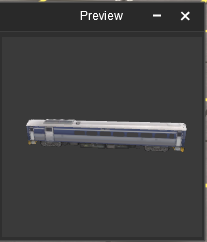 |
The Asset Preview Palette can be enlarged once it has been undocked.
The current Surveyor 2.0 version has no display or control options and lacks the "zoom" and other features found in the Preview function of Content Manager. |
The Content Packages Palette
|
 |
|
 |
 |
 |
 |
This is a Surveyor Only palette
 |
This palette is mainly intended for content creators, particularly MPS (Multi Player Surveyor) content. It helps manage, prepare and upload to the MPS Server a user created "Content Package". The web site for the TCCP (Trainz Content Creation Program), which is not MPS specific, can be found at info.trainzsimulator.com/tccp |
For a more technical description of using the Content Packages Palette see the Trainz Wiki page  Content Packages Content Packages |
|
 |
Notes:
 |
The Content Packages Palette is intended for use by Content Creators , particularly those creating MPS (Multi Player Surveyor) routes . But it can be used by anyone to help manage installed packages and identify their details and contents. |
 |
Its content creation function does not support session data - it is for routes only |
|
|
The palette lists all the installed Content Packages that have assets available for use. Two special packages are included in the list:-
 |
All Installed Content which covers all offline (non-MPS) content, and |
 |
multiplayersurveyor which includes all the default content on the live MPS Server |
 |
Enabling packages in an MPS Route will prompt other users who download the Route to install the same packages |
|
Content Package Details
|
 |
 |
|
|
|
|
 |
| Steps: To view the details of a package:- |
 |
Right Click on the package name |
 |
Select the option View Details |
|
|
Some packages will display the message 
If details are available then something like the following example will be shown.
 |
Warning:
If you Uninstall a package you will also delete any Packaged assets it contains that may be needed by other assets on your system, such as routes. Packaged assets may (or may not) be found on the DLS - that is a decision made by the creator of the package. They are not Payware but come as part of an installed DLC package. Trainz has no way of knowing if a "packaged" asset it is about to delete had previously been "Installed from the DLS", and could therefore be needed elsewhere, or was only installed with the package.
Uninstalling a package can leave you with some (or many) "Missing dependency" error messages. The remedy is to use Content Manager to first perform a DBR (database repair) and then download the missing dependencies from the DLS BUT it is possible that some of the "missing dependencies" can only be found in the DLC Package you have just uninstalled. |
|
Testing the Packages
|
 |
 |
|
|
|
|
 |
While you can manually select the packages to be enabled, an easier option may be to let the program perform that task. |
With or without any packages enabled, Left Click on the icon showing 3 horizontal bars (bottom right) to open a menu.

| Automatically Enable Required Packages |
attempts to automatically identify and enable the minimum number of packages required by the current route. This only affects the packages listed in the palette and nothing else |
| List Assets Unsupported by Enabled Packages |
this will either:- |
 |
open Content Manager with a window displaying all the assets (objects) used in the current route that are not found in the enabled packages, OR |
 |
give the preferred result as shown in the following message
 |
|
|
| Steps: To identify the assets that are required by the current route that are not supported by the enabled packages:- |
 |
Disable all packages - the Revert button will reset any enabled packages leaving only the top package enabled |
 |
Select the menu option Automatically Enable Required Packages . There may be a delay of a few seconds. |
 |
Select the menu option List Assets Unsupported by Enabled Packages |
|
Dealing with Unsupported Assets
|
 |
 |
|
|
|
|
 |
If you have manually selected and enabled the packages you want to include and have been shown a list of assets that are not supported by your selection, then you will need to identify the missing packages (if any) and add them manually.
| Steps: To identify and add missing packages:- |
 |
Left Click on the first asset in the Content Manager window |
 |
open the Content Menu and select the option Report Containing Packages |
 |
note the ID of the package. If no ID is shown then the asset does not belong to an installed package (see option  below for dealing with these assets) below for dealing with these assets) |
 |
repeat for each asset in the Content Manager list |
 |
Enable the identified missing packages. The IDs of all the installed packages can be found by using the steps described in  Content Package Details above Content Package Details above |
|
|
 |
If you have used the Automatically Enable Required Packages option then any unsupported assets found will not belong to any installed packages. In this case you will need to create a new package using TCCP and add them to that package - see the Trainz Wiki Page at  TCCP Content Creation. If that is not a suitable option then you will need to either remove the unsupported assets from the route or replace them with supported assets. TCCP Content Creation. If that is not a suitable option then you will need to either remove the unsupported assets from the route or replace them with supported assets. |
Apply and Upload
|
 |
 |
|
|
|
|
Once you have enabled the required packages, you need to prepare the route for uploading to the live MPS Server
The next step is to upload the new package to the live MPS Server.
| Steps: |
 |
Open the  Surveyor Sharing Menu from the Main Menu icons Surveyor Sharing Menu from the Main Menu icons |
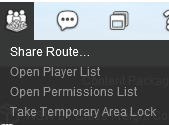 |
 |
Select the option Share Route . You will receive a warning that Session Data is not supported. |
 |
To proceed Left Click OK
To cancel the upload Left Click Cancel |
|
 |
Assuming that you selected OK then the route will be packaged and uploaded to the live MPS Server. A successful upload will be indicated by the final message as shown below:-
 |
A route that has been uploaded to the MPS Server will appear with a colour band in the Surveyor Select a Route/Session window. |
|
|
|
|
This is both a Surveyor palette and a Driver palette (where it is named the Driver Control Center)
 |
In Surveyor if the Drivers Palette is not visible on the screen then refer to  Hiding and Showing Palettes at the top of this document Hiding and Showing Palettes at the top of this document |
 |
In Driver to show the Driver Control Centre on the screen either:-
 |
Left Click on the Driver Icon at the bottom left of the screen OR |
 |
open the  Window Menu and select the Driver Control Center option Window Menu and select the Driver Control Center option |
|
|
 |
This palette provides a full list of available drivers, their assigned trains and the tools to manage them in both Surveyor and Driver |
 |
In Driver the palette is named the Driver Control Center |
Adding a Driver
|
 |
 |
|
|
|
|
 |
New drivers can be added to the Drivers Palette |
 |
Notes:
|
| A randomly selected driver will be automatically added to the Drivers Palette when a locomotive is added to your Trainz World. The driver will be assigned to the new locomotive |
|
|
Assigning Drivers
|
 |
 |
|
|
|
|
 |
A driver that has no currently assigned train can have one assigned to them |
| Steps: To assign a driver to a train:- |
 |
 |
Move to Destination
Left Click on the icon to select a new train for the driver. The Drivers Palette will change to the image shown below right |
|
 |
If this tool cannot be selected then check if the driver has been set to Not Assigned . If necessary you can change the setting to Player Controlled but that may affect other operations such as the TLR |
|
|
Then...
Switching Drivers
|
 |
 |
|
|
|
|
 |
A driver that is currently assigned to a train can be reassigned to a different train or to no train |
| Steps: To switch a driver from one train to another:- |
 |
 |
Get off Train
Left Click on the icon to leave the assigned train so that the driver can be assigned to another or none |
|
| Once the driver has left the train, the icon will change to a new design |
 |
 |
Move to Destination
This is optional. You can reasign the driver by a Left Click on the new icon to select a new train for the driver. The Drivers Palette will change to the image shown below right |
|
 |
If this tool cannot be selected then check if the driver has been set to Not Assigned . If necessary you can change the setting to Player Controlled but that may affect other operations such as the TLR |
|
|
Then...
Driver Properties
|
 |
 |
|
|
|
|
 |
Notes:
|
 |
These features are mostly intended for use in the upcoming Trainz Living Railroad (TLR) but some can be used with normal Sessions |
 |
They will have no effect in the running of normal (non-TLR) Sessions |
|
After selecting the  View Driver Properties Tool, the following Properties window will open.
View Driver Properties Tool, the following Properties window will open.
| In Driver |
When used in Driver Mode a green line will appear above the track showing the path that will be taken when the next command in the Command Status queue is a Drive or Navigate command.
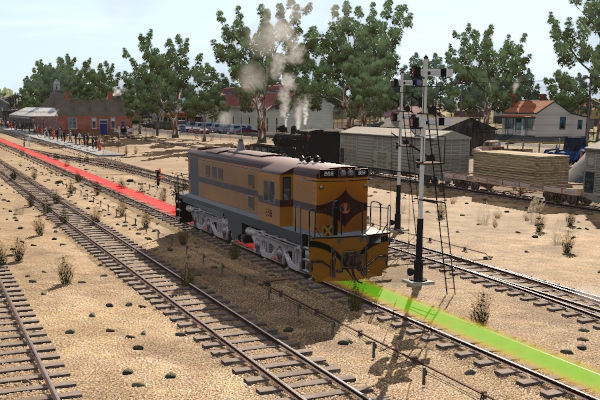 |
 |
Notes:
|
 |
The signals and switches along the path may not be correctly set until the train approaches and activates them |
 |
The path will be visible as long as the Driver Properties window is open (but it can be minimised) |
|
|
To open this palette in Driver:-
Options: |
 |
From the Driver Icon:-
| Steps: |
 |
Left Click on the Driver Icon at the bottom left of the screen |
 |
select the driver from the driver list (Left Click on its Eye icon if it is not the driver with the focus) |
 |
Left Click on the  View Driver Properties Tool for that driver View Driver Properties Tool for that driver |
|
 |
From the Window Menu:-
| Steps: |
 |
Open the  Windows Menu and select Driver Control Center Windows Menu and select Driver Control Center |
 |
select the driver from the driver list (Left Click on its Eye icon if it is not the driver with the focus)
|
 |
Left Click on the  View Driver Properties Tool for that driver View Driver Properties Tool for that driver |
|
|
| Left Click on the Close button to close the window and return to the Drivers Palette BUT closing will turn off the path line. To keep the line on the screen Minimise the window instead. |
Driver Location
|
 |
 |
|
|
|
|
 |
This allows you to move the driver to a new train and to view/edit the details of their current train |
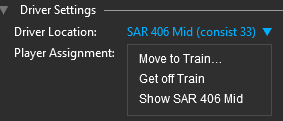 |
| Steps: To edit the driver location:- |
 |
Left Click on the white Down Arrowhead following the name of the assigned locomotive |
 |
select an option from the drop down menu |
|
|
Choose one of the following:-
Options: |
 |
Get off Train |
the driver assignment to this train will be terminated, OR |
 |
Show <name of loco> |
this will open a new Properties window showing details of the assigned train. Some of those details can be edited. See Train Properties below |
|
|
|
| Left Click on the Close button to close the window and return to the Drivers Palette. |
Train Properties
| The Show <name of loco> option will open the Train Properties window |
|
Left Click on the Close button to close the window and return to the Driver Properties window. |
Script Properties
 |
| Steps: To display the legacy script properties of the locomotive:- |
 |
Left Click on the window icon  to open the Script Properties window to open the Script Properties window |
 |
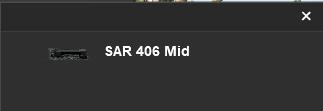 |
Left Click the  button to close the window button to close the window |
|
|
You can edit the Script Properties of a locomotive.

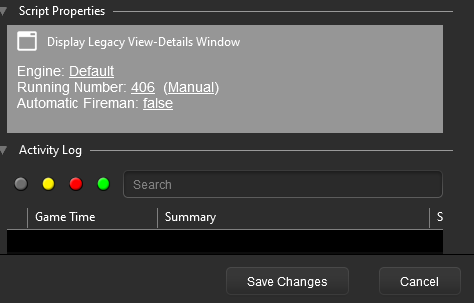 |
| Steps: To edit the Script Properties:- |
 |
Left Click on the Enable Editing button |
 |
All the script controlled properties of that particular locomotive, as shown left, can be opened (Left Click on the link) and edited |
 |
To Save your edits Left Click on the Save Changes button, OR
To Cancel your edits Left Click on the Cancel button |
|
|
|
|
Player Assignment
|
 |
 |
|
|
|
|
 |
This allows you to set a driver as available or not available for assignment to a train |
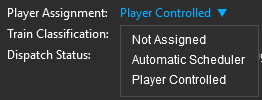 |
| Steps: To change a driver assignment:- |
 |
Left Click on the white Down Arrowhead following the name of the player |
 |
select an option from the drop down menu |
|
|
Choose one of the following:-
Options: |
 |
Not Assigned |
makes the driver unavailable but keeps them in the driver list, OR |
 |
Player Controlled |
returns the driver to active duty in the driver list |
|
|
|
|
Left Click on the Close button to close the window and return to the Drivers Palette. |
Command Status
|
 |
 |
|
|
|
|
 |
The Command Status displays the list of driver commands waiting for execution by the selected driver |
 |
New driver commands can be added and existing commands removed |
 |
A sample list of driver commands |
|
|
|
Left Click on the Close button to close the window and return to the Drivers Palette. |
Activity Log
|
 |
 |
|
|
|
|
 |
This allows you to monitor the activity and progress of a driver |
 |
This gives a detailed list of every operation started and completed by the selected driver. In the example shown on the left this includes gaining and releasing "permits" (access or permission) for each junction switch along the drivers path.
 |
the display area has a vertical scroll bar on the right for longer reports |
 |
Left Click on the coloured dots to toggle them on/off and filter the log entries by message type |
 |
Left Click in the Search text box to enter a text string to filter the log entries |
|
|
|
Left Click on the Close button to close the window and return to the Drivers Palette. |
This is a Surveyor Only palette
 |
This palette displays the Trainz System Log which details the loading of assets, the operation of scripts, messages displayed on the screen (in Driver), etc. It is for diagnostic purposes. |
The Session Options Palette
|
|
|
 |
 |
 |
 |
This is a Driver Only palette
 |
This palette allows you to change session settings in Driver "on the fly" |
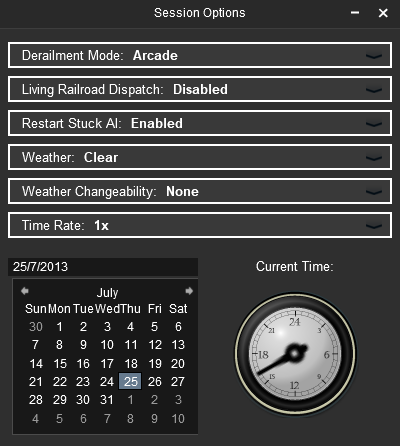 |
Each item shown in the palette can be edited:-
 |
Left Click on a boxed item to select an option from its drop down menu |
 |
In the calendar Left Click on date (the day and/or the left/right month arrows) to change the season of the year or enter a new date in the text entry box (the year entered does not matter) |
 |
In the clock Left Click and Drag the clock hand around the dial to change the time of day |
|
|
|
 |
This palette cannot be resized |
|
|
The Commodity Picker Palette
|
|
|
 |
 |
 |
 |
This is a Driver Only palette
 |
This palette allows you to change the commodities (products) carried by rolling stock in Driver "on the fly" |
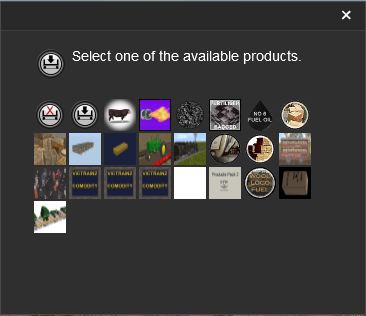
 |
This palette cannot be minimised or resized |
|
|
| Steps: To change the commodities (products) carried by a rolling stock object:- |
 |
move the mouse pointer onto a commodity icon in the Picker. A Tooltip identifying the product will appear on the pointer |
 |
Left Click on an icon to select its commodity. The message at the top of the palette will change to confirm the selection
 |
 |
move the pointer onto the rolling stock asset that will have its product queue restricted to the selected product only. The mouse pointer will have a Load icon  attached to it attached to it
|
 |
Left Click on the rolling stock object to restrict it to the selected product only. If the change is accepted then the mouse pointer will change to the icon for the selected product 
 |
The selection will fail if the rolling stock object has not been configured to accept the selected commodity. Failure is indicated when the Load icon attached to the pointer does not change |
|
|
|
This is a Driver Only palette
 |
This palette displays the active message windows that were created for this session by a HTML Asset or a Message Popup Rule starting with the last one |
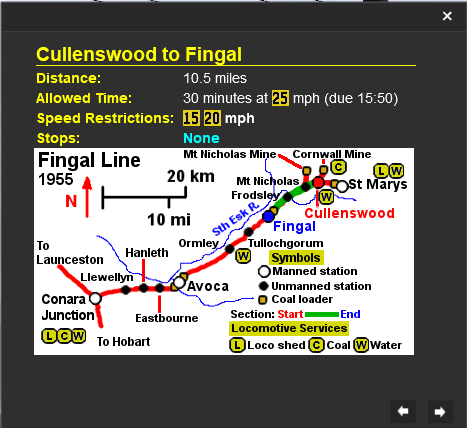 |
 |
Notes:
This palette can also be displayed by pressing the F1 function key. |
 |
If no HTML Asset or Message Popup Rule exists in the session, or those present have not yet been activated, then nothing will be displayed. |
 |
This palette cannot be minimised or resized. |
 |
Left and Right arrow icons at the bottom of the palette will allow you to move forward and back through any other message windows that have been activated for this session. |
 |
A  icon indicates no more messages. Left Click on the icon indicates no more messages. Left Click on the  or the or the  icons to close the palette icons to close the palette |
|
|
This is a Driver Only palette
 |
This palette displays the commodity deliveries and pickups for this train |
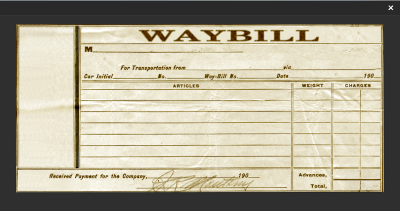 |
 |
Notes:
|
 |
This palette cannot be minimised or resized. |
 |
Left Click on the  icon to close the palette. icon to close the palette. |
|
|
The Schedule Info Palette
|
|
|
 |
 |
|
 |
This is a Driver Only palette
 |
This palette displays the Trainz Living Railroad (TLR) schedule for the train |
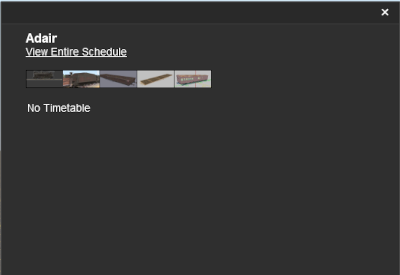 |
 |
Notes:
|
 |
This palette will not be functional until the full implementation of the Trainz Living Railroad (TLR) feature. |
 |
This palette cannot be minimised. |
 |
Left Click on the  icon to close the palette. icon to close the palette. |
|
|
Trainz Wiki
 |
More Tutorials and Guides to Using Trainz
|
This page was created by Trainz user pware in February 2023 and was last updated as shown below.
Surveyor 2.0 Overview



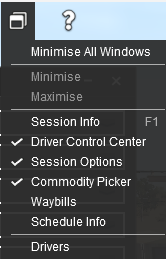

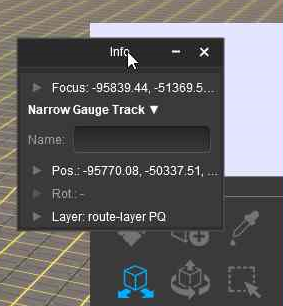
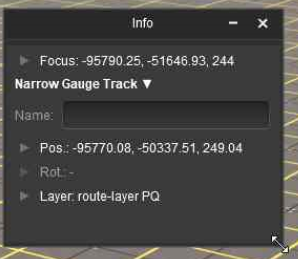










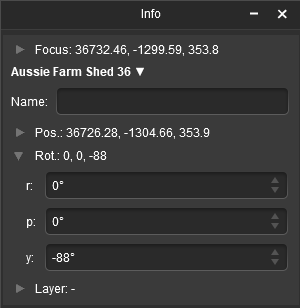

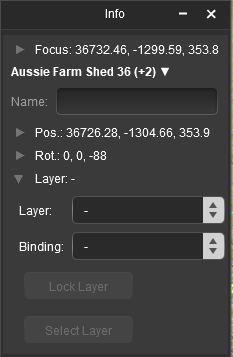
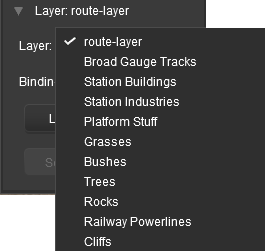






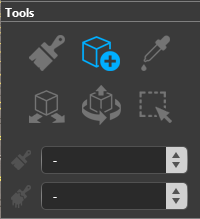


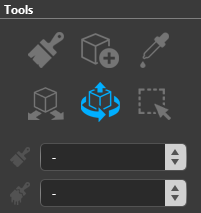








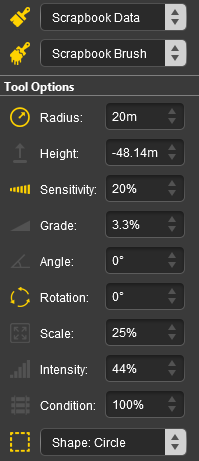


The first filter option controls where the filters are applied.

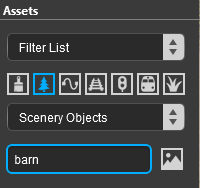
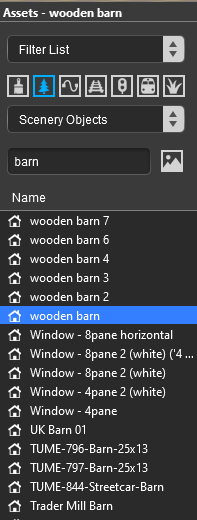

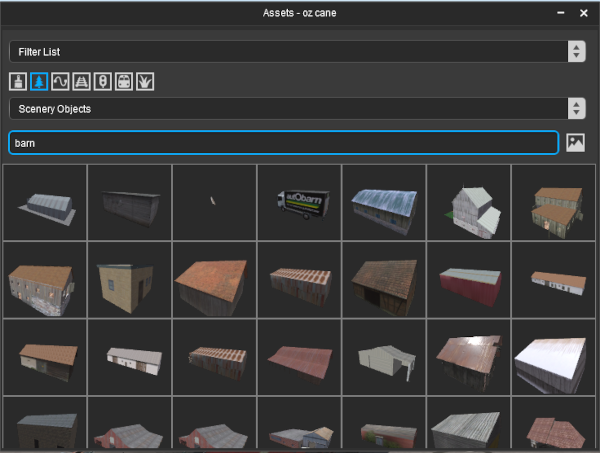

![]() (unlocked).
(unlocked).












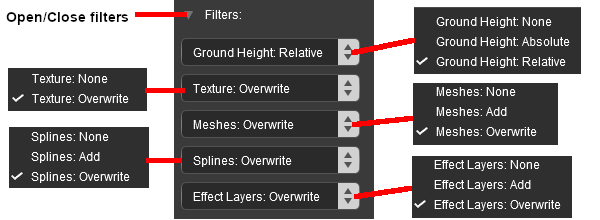

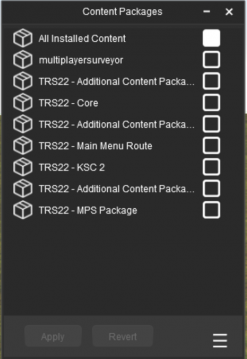

![]()
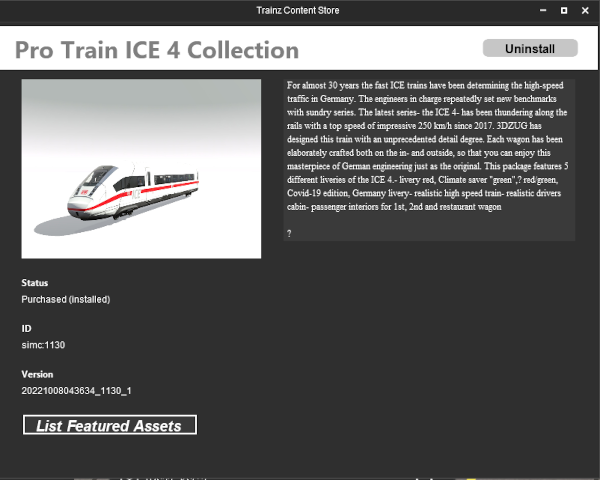


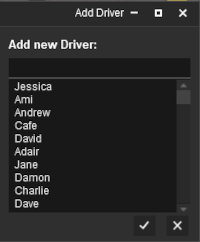
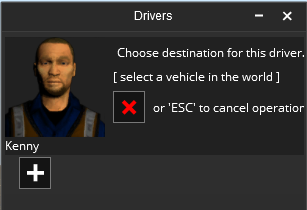

![]() View Driver Properties Tool, the following Properties window will open.
View Driver Properties Tool, the following Properties window will open.